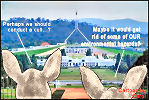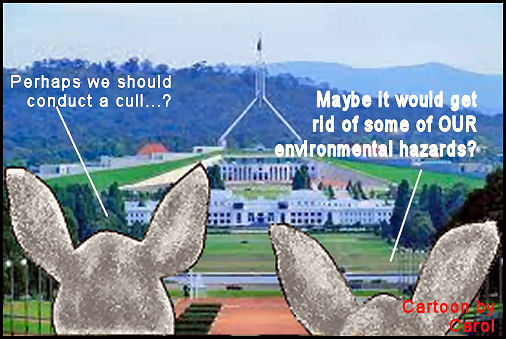Killing is kindness? - Musings on Canberra kangaroo cull to make way for yet more houses

Author Margaret Warner has produced a new fun book and guide for teachers and children to learn about an animal that should be celebrated and honoured as endemic to Australia, and one of the world's most recognizable national symbols.
Targeted for ages 7 - 12 years, with all pages photocopy masters suitable for school use.  Paddy Weaver writes in support of protests in Canberra against roo slaughters. "I would want to see very strong evidence that roos had done more than contribute to the ecosystem changes. When mankind has spread our pollutants from the Arctic to the Antarctic, I think we need to stop pretending that any environment is unaffected by human activity."
Paddy Weaver writes in support of protests in Canberra against roo slaughters. "I would want to see very strong evidence that roos had done more than contribute to the ecosystem changes. When mankind has spread our pollutants from the Arctic to the Antarctic, I think we need to stop pretending that any environment is unaffected by human activity."
By Dr Paddy Weaver, Biochemist

I have wondered for some time at Canberra's fondness for culling its kangaroos. I know they are probably a different species to our Perth hoppers but the roos here thrive on the golf courses. Initial calls for culling were over ridden by a public outcry. Now golfers and roos coexist quite amicably and have made the courses really popular with Japanese tourists. The trees and bushland "roughs" survive the onslaught of both. Certainly our roos exist in places with no ready access to water, although some on waterless peninsulas or dry coastal areas go close to the water's edge, scoop a shallow hole and drink the brackish water that accumulates.
I would suggest translocating roos to the lawns of Parliament House where I am sure they could graze quite nicely. An emu or two would complete the emblematic significance. Although I am told they are not as bright as roos and take longer to learn to avoid the traffic. But probably the slowest to learn appropriate behaviour (keeping to their own space) would be the people.
The public often relies on ecological opinion, but ecologists do have their limitations. Perth has just discovered that pollutants in our Swan River are causing fish and snails to develop dual sex organs. Years ago when I served on an advisory committee to the Minister for Fisheries I tried to persuade the fishery ecologists to look at endocrine disruptors. No go. They had never heard of these compounds or their effects but got quite a shock when all their colleagues in the Japanese research facilities including the ecologists were directed to work on these exclusively. Goodbye joint projects. Now we have glaring examples of some of the effects of these compounds in Swan river fish. No established link as yet but I make a bet it will come, I may not be around to see it.
Many years ago a colleague working on insects and ecdysone and I swapped our control compounds and bingo, his insects and my plant cell cultures reacted not only to the other's control hormone, but also to a range of human steroid hormones. Not the full response of course, but quite a significant effect.
The steroid receptor appears to have an early evolutionary origin and thus some receptor-hormone binding is found for compounds with this control function from widely ranging species from plants to mammals. Someone else published this before we were ready so we never did. There is no Journal for Reproducible Results.
I am just making the point that ecologists are essentially conservative like most scientists. I will bet the bushland environment that is to be cleared has had windblown spray from herbicides, perhaps steroids from the pill or a host of the synthetic disruptors from plastic fillers etc. in groundwater. I would want to see very strong evidence that roos had done more than contribute to the ecosystem changes. When mankind has spread our pollutants from the Arctic to the Antarctic, I think we need to stop pretending that any environment is unaffected by human activity.
Black cockatoos in Perth have gone from prolific pest to rare and endangered in such a short time span that I hate to see culling of native animals for any reason.
WA has had to try relocating some of the rare and endangered species from our richest and most precious fauna reserve, condemning the rest to extinction. It has sacrificed much of the world's oldest and largest collection of rock carvings at a world monument site and is now about to build a gas hub over the dinosaur footprint trail - all for the economic greed of our political and business leaders.
Perhaps a few protests from Canberra at culling kangaroos would help the general education process.

Recent comments